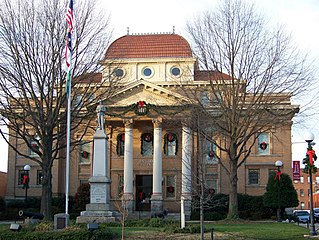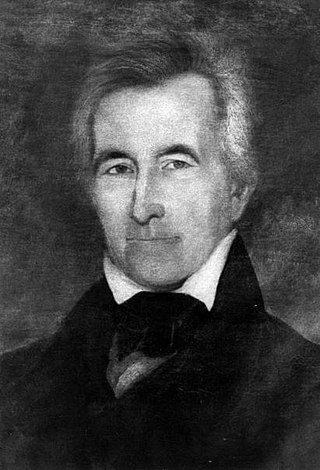Related Research Articles

Charlotte is the most populous city in the U.S. state of North Carolina and the seat of Mecklenburg County. The population was 874,579 at the 2020 census, making Charlotte the 15th-most populous city in the United States, the seventh-most populous city in the South, and the second-most populous city in the Southeast behind Jacksonville, Florida. Charlotte is the cultural, economic, and transportation center of the Charlotte metropolitan area, whose estimated 2023 population of 2,805,115 ranked 22nd in the United States. The Charlotte metropolitan area is part of an eighteen-county market region or combined statistical area with an estimated 2023 population of 3,387,115.

York County is a county on the north central border in the U.S. state of South Carolina. As of the 2020 census, the population was 282,090, making it the seventh-most populous county in the state. Its county seat is the city of York, and its most populous community is Rock Hill. The county is served by one Interstate Highway, Interstate 77.

Lancaster County is a county located in the U.S. state of South Carolina. As of the 2020 census, its population was 96,016, Its county seat is Lancaster, which has an urban population of 23,979. The county was created in 1785.

Mecklenburg County is a county located in the southwestern region of the U.S. state of North Carolina, in the United States. As of the 2020 census, the population was 1,115,482, making it the second-most populous county in North Carolina, and the first county in the Carolinas to surpass one million in population. Its county seat is Charlotte, the state's largest municipality.

Iredell County is a county located in the U.S. state of North Carolina. As of the 2020 census, the population was 186,693. Its county seat is Statesville, and its largest community is Mooresville. The county was formed in 1788, subtracted from Rowan County. It is named for James Iredell, one of the first justices of the Supreme Court. Iredell County is included in the Charlotte-Concord-Gastonia, NC-SC Metropolitan Statistical Area, as defined by the Office of Management and Budget, with data from the U.S. Census Bureau.

Lincolnton is a city in Lincoln County, North Carolina, United States within the Charlotte metropolitan area. The population was 10,486 at the 2010 census. Lincolnton is northwest of Charlotte, on the South Fork of the Catawba River. The city is the county seat of Lincoln County.

The Catawba, also known as Issa, Essa or Iswä but most commonly Iswa, are a federally recognized tribe of Native Americans, known as the Catawba Indian Nation. Their current lands are in South Carolina, on the Catawba River, near the city of Rock Hill. Their territory once extended into North Carolina, as well, and they still have legal claim to some parcels of land in that state. They were once considered one of the most powerful Southeastern tribes in the Carolina Piedmont, as well as one of the most powerful tribes in the South as a whole, with other, smaller tribes merging into the Catawba as their post-contact numbers dwindled due to the effects of colonization on the region.
Denver, formerly known as Dry Pond, is a census-designated place and unincorporated community in Lincoln County, North Carolina, United States. As of the 2010 census it had a population of 2,309.
The Waxhaws is a geographical region extending beyond both sides of the border between what now is North Carolina and South Carolina, United States. It encompasses the areas currently known as Lancaster, Union and Mecklenburg counties. The name is derived from that of the Indigenous people who first inhabited the landbase, the Waxhaw people. Much of the area is now the territory of the Catawba Indian Nation.
Alexander Craighead (1705–1766) was a Scots-Irish American preacher.

The Battle of Fishing Creek, also called the Battle of Catawba Ford, was an American Revolutionary War battle fought on August 18, 1780, between American and British forces including the 71st Foot. It was fought near the junction of Fishing Creek and the Catawba River in South Carolina. British forces under Banastre Tarleton surprised the militia company of Thomas Sumter, killing a significant number, taking about 300 captives, and very nearly capturing Sumter, who some say was asleep at the time of the attack.

William Lee Davidson (1746–1781) was an officer in the North Carolina militia and Continental Army during the American Revolutionary War. He was born in Pennsylvania and moved with his family to Rowan County, North Carolina in 1750. He was killed at the Battle of Cowan's Ford.
The Battle of Cowan's Ford took place in the Southern Theater of Cornwallis's 1780–1782 Campaign during the American Revolutionary War. It was fought on February 1, 1781, at Cowan's ford on the Catawba River in northwestern Mecklenburg County, North Carolina, between a force of about 2,400 British and about 800 Whig militia who were attempting to slow the British advance across the river. The American general William Lee Davidson was killed in this battle.

The Buster Boyd Bridge is a four-lane automobile bridge spanning the Catawba River/Lake Wylie between Lake Wylie, York County, South Carolina and Steele Creek, Mecklenburg County, North Carolina. The bridge carries/connects SC 49 and NC 49, which is utilized by mostly local traffic. A sidewalk, along the east facing side of the bridge, provides pedestrian access.
Abraham Alexander was a public figure in Mecklenburg County, North Carolina, during the American Revolution. He chaired the meetings that produced the radical Mecklenburg Resolves and, allegedly, the Mecklenburg Declaration of Independence.

The Battle of Torrence's Tavern was a minor engagement of the American Revolutionary War that took place in what was the western portion of Rowan County, North Carolina, approximately 10 miles (16 km) east of the Catawba River near modern-day Mooresville in Iredell County. Torrence's Tavern was a part of the larger Southern campaign of the American Revolution, which, by 1780–1781 involved a series of clashes between the British Army and Loyalist militia and the Continental Army and Patriot militia in the Piedmont region of North and South Carolina.

Thomas Polk was a planter, military officer in the Continental Army during the American Revolutionary War from 1775 to 1781, and a politician who served in the North Carolina House of Commons, North Carolina Provincial Congress, and Council of State. Polk commanded the 4th North Carolina Regiment in the Battle of Brandywine. In 1786, Polk was elected by the North Carolina General Assembly to the Congress of the Confederation, but did not attend any of its sessions. Polk was a great-uncle of the 11th President of the United States, James K. Polk.

Joseph Graham was a Revolutionary War militia officer, politician, and wealthy ironmonger from Mecklenburg County, North Carolina.
Thomas Gillespie was a large plantation owner in mid-to-late 18th-century North Carolina and served as commissary of the Rowan County Regiment in the North Carolina militia during the American Revolution. He spent his early life in Augusta County, Virginia before migrating to Anson County, North Carolina in about 1750, where he lived most of his life on Sills Creek in the area that became Rowan County, North Carolina in 1753. He and his wife and son were the first white settlers west of the Yadkin River. He owned a plantation of over 1,000 acres on Sills Creek in Rowan County, as well as 6,000 acres in the area of western North Carolina that became part of the state of Tennessee in 1796. He was an early elder in the Thyatira Presbyterian Church in Rowan County, which had been established by 1750. Thomas was the great-grandfather of U.S. President James K. Polk through the lineage of his daughter Lydia, who married Captain James Knox and gave birth to Jane Gracey Knox, mother of the President.

Rev. James Hall, D.D. was a Presbyterian minister, chaplain in the Rowan County Regiment during the American Revolution, educator, and missionary in the Natchez area of the Mississippi Territory. He helped to found the Fourth Creek Congregation as its second minister. He was the first minister of Concord Presbyterian Church and Bethany Presbyterian Church in Iredell County, North Carolina on April 8, 1778.
References
- ↑ A history of the Sugaw Creek Presbyterian Church, Mecklenburg Presbytery, Charlotte, North Carolina
- ↑ The Charlotte Mecklenburg Story: Sugar Creek or Sugaw Creek
- ↑ Daniel W. Barefoot, Touring NC Revolutionary War Sites
- ↑ River of the Carolinas: the Santee (1968)